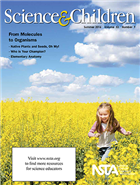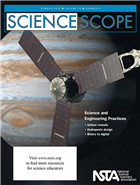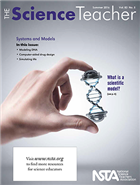Ideas and information from NSTA's Summer K-12 journals
By Mary Bigelow
Posted on 2016-07-24
These issues are great additions to your summer reading list! Most of the lessons in these journals include a detailed chart connecting the lesson to the NGSS.
 Science and Children – From Molecules to Organisms
Science and Children – From Molecules to Organisms
The featured articles focus on developing a progression of learning for younger students.
- Native Plants and Seeds, Oh My! – Using a plant found in the school garden (milkweed), this lesson includes several parts on the basics of plants and investigations with native plants. Photographs show students at work.
- Who Is Your Champion? – With a focus on designs and models, students consider the question “What can we learn from plants and animals to help solve the problems we face in our lives?”
- Stalk It Up to Integrated Learning – Plant parts as food is the basis for this set of learning activities.
- Elementary Anatomy – Young students enjoy learning about themselves. This lesson for preschool students helps students learn about body parts they can’t see.
- Learning About Plants With STEAM – This year-long project incorporates the arts and sciences, using plants in an outdoor garden as a focus.
- Teaching Through Trade Books: The Purpose of Individual Parts and Processes – These two 5E lessons help K-2 and 3-5 students understand life cycles and the purposes of different parts of an organism.
- Formative Assessment Probes: Big and Small Seeds – Probes such as this one can be used in developing student understanding of science and engineering practices.
- The Early Years: Discovering Through Deconstruction – Students can learn from taking things apart to go from the whole to its parts. This lesson for young children deconstructs a fruit to learn about plant parts.
- Making the Transition to Three-Dimensional Teaching – Using the EQuIP rubric can help evaluate resources and align them to the NGSS.
- Science 101: Q: How Do We Distinguish Between Living and Nonliving Things? – This article for teachers has thoughts on this deceptively simple question.
For more on the content that provides a context for these projects and strategies see the SciLinks topics Butterflies, Characteristics of Living Things, Factors Affecting Plant Growth, Invasive Species, Life Cycles, Plants as Food, Plants with Seeds, Seed Germination, Structure of Seed Plants.
Continue for Science Scope and The Science Teacher
 Science Scope – Science and Engineering Practices
Science Scope – Science and Engineering Practices
As you read the articles, take note of how the learning activities address science and engineering practices:
- Asking questions (for science) and defining problems (for engineering)
- Developing and using models
- Planning and carrying out investigations
- Analyzing and interpreting data
- Using mathematics and computational thinking
- Constructing explanations (for science) and designing solutions (for engineering)
- Engaging in argument from evidence
- Obtaining, evaluating, and communicating information
- Evaluating the Egg Drop: Using the EQuIp Rubric to Ensure Activities Meet the Next Generation Science Standards – See how a teacher updated a lesson to incorporate the three dimensions of NGSS, increasing student interest at the same time.
- Tried and True: Falling in Style – This 5E lesson is a variation on the egg-drop investigation, in which students design and test parachutes while learning about air resistance and gravity.
- WISEngineering Hydroponics: A Technology-Enhanced, Life Science Engineering Design Unit – Using the WISEngineering simulation, www.wisengineering.org students design a system for growing plants without soil. The article includes photographs of the projects and screenshots of the simulation.
- Engineering Technology for the Digital World – Students are very familiar with technology, but do they understand how their devices work? This activity introduces them to the binary system as they build and text a circuit board.
- Engineering Seltzer Rockets – Rather than expensive model rocket kits, students use simple materials to design and test rockets. This enables them to explore variables and conduct multiple tests.
- Bone Tissue Engineering: An Interactive Engineering Design Module – To address a real-world situation, students become biomedical engineers as they design and test a cranial mesh implant
- Teacher’s Toolkit: The New Standard in Technology Education: 3-D Design Class – Students get excited about using new technology, but the des
ign process is just as important as the technology. The authors note that “In order to benefit from 3-D printing technology in the classroom, students need to build a skill set in 3-D modeling” and include an outline of the process (see The Science Teacher for more on modeling.)
For more on the content that provides a context for these projects and strategies see the SciLinks topics Biomedical Engineer, Cellular Respiration, Force of Gravity, Forces and Motion, Hydroponics, Newton’s Laws, Photosynthesis, Skeletal System.
 The Science Teacher – Systems and Models
The Science Teacher – Systems and Models
Students and parents often have a misconception of scientific models. The editor notes that “art projects, physical replicas, posters, and diagrams are not really scientific models, although they can be valuable learning experiences. ….a true model must be useful to explain natural phenomena and make predictions.”
- Crafting a Masterpiece – The author shares his experiences in using the EQuIP rubric to redesign lessons.
- Modeling DNA – Among other activities in this 5E lesson, students position their bodies to create a DNA model; they also use other materials to illustrate the structure and function of DNA.
- Explaining Ramps With Models – The authors described how this approach to learning resulted in more in-depth understanding. They include design strategies and photographs to illustrate student work.
- Computer-Aided Drug Design – Computers have enhanced the modeling process. Find out how students took on the role of “medicinal chemist” and used software simulations focused on cancer drugs to see the relationship between chemistry and biology.
- Simulating Life – This article looks at the emerging field of biomodeling. Students use simple materials (e.g., dice) and mathematics to analyze and predict bacteria movement.
- Connecting the Visible World With the Invisible – Throughout the year, students created and used particulate diagrams to represent their knowledge of elements, mixtures, and compounds.
- Science 2.0: Soaring in a Digital Ecosystem – The authors describe a taxonomy of technology processes: substitution, augmentation, modification, and redefinition. The latter two are part of how technology can transform a classroom.
- Focus on Physics: The Equilibrium Rule—A Personal Discovery – Here’s a refresher on the topic, with illustrations and examples.
For more on the content that provides a context for these projects and strategies see the SciLinks topics Acceleration, Balanced and Unbalanced Forces, Compounds, DNA Structure and Function, Elements, Equilibrium, Mixtures, Motion, Velocity
Disclaimer: The views expressed in this blog post are those of the author(s) and do not necessarily reflect the official position of the National Science Teaching Association (NSTA).

